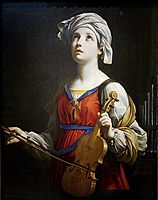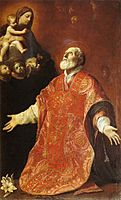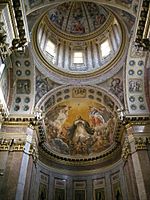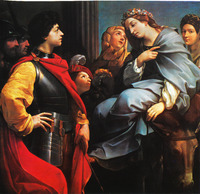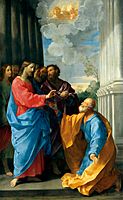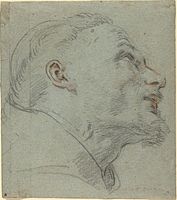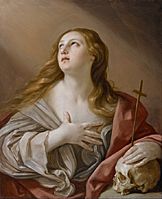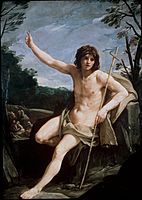Guido Reni facts for kids
Quick facts for kids
Guido Reni
|
|
|---|---|
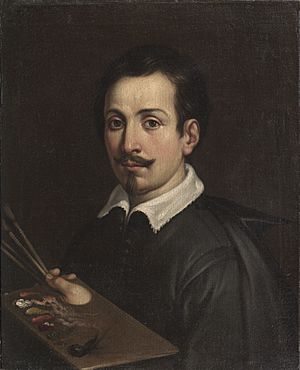
Self portrait, c. 1602
|
|
| Born | 4 November 1575 |
| Died | 18 August 1642 (aged 66) Bologna
|
| Nationality | Italian |
| Known for | Painting |
| Movement | Baroque |
Guido Reni (born November 4, 1575 – died August 18, 1642) was a famous Italian painter from the Baroque period. His paintings often had a classic style, similar to artists like Simon Vouet and Nicolas Poussin. He mostly painted religious scenes, but also pictures about myths and stories. He worked in Rome, Naples, and his hometown, Bologna. He became a very important artist in the Bolognese School, which was influenced by the Carracci family of painters.
Contents
Life and Training of a Painter
Guido Reni was born in Bologna, Italy, in 1575. His family loved music. When he was just nine years old, he started learning to paint in the studio of Denis Calvaert. Other famous painters like Albani and Domenichino also trained there with him.
When Reni was about 20, he and his friends from Calvaert's studio moved to a new, exciting art school. This school was called the Accademia degli Incamminati, which means "Academy of the newly embarked" or "progressives." It was led by Lodovico Carracci. These young artists became the core of a very successful group of Bolognese painters. They followed Ludovico's cousin, Annibale Carracci, to Rome.
While at the Carracci academy, Reni got his first jobs painting altarpieces for churches. He left the academy around 1598 after a disagreement with Ludovico Carracci about not being paid for his work. Around this time, he also made his first prints, which were pictures made to remember Pope Clement VIII's visit to Bologna in 1598.
Working in Rome
In late 1601, Reni and Albani moved to Rome. They worked with teams led by Annibale Carracci on painting large murals, called frescoes, in the Farnese Palace. By 1604–1605, Reni received his own job to paint an altarpiece called Crucifixion of St. Peter.
After a short visit back to Bologna, he returned to Rome. He became one of the top painters during the time of Pope Paul V. Between 1607 and 1614, the powerful Borghese family hired him for many paintings.
One of Reni's most famous fresco masterpieces is L'Aurora (The Dawn). It is located in the Casino dell' Aurora on the grounds of the Palazzo Pallavicini-Rospigliosi. This building was originally a small palace ordered by Cardinal Scipione Borghese.
This huge fresco shows Apollo in his chariot, with Dawn (Aurora) leading the way and bringing light to the world. The painting has a calm, classical style. It uses poses copied from ancient Roman artworks. It is much simpler than Carracci's busy Triumph of Bacchus and Ariadne in the Farnese. Reni was paid 247 scudi for this work when he finished it in 1616.
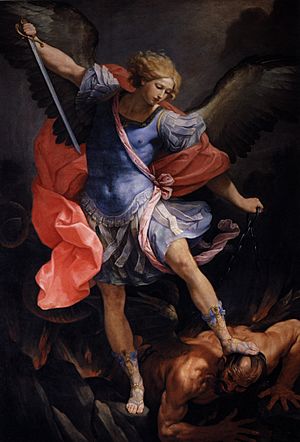
In 1630, the Barberini family, who included Pope Urban VIII, asked Reni to paint a picture of the Archangel Michael. This painting was for the church of Santa Maria della Concezione dei Cappuccini. The painting was finished in 1636. There's an old story that Reni painted Satan, who is crushed under St. Michael's foot, to look like Cardinal Giovanni Battista Pamphilj. This was supposedly Reni's way of getting back at the Cardinal for something he did.
Reni also painted frescoes in the Paoline Chapel of Santa Maria Maggiore in Rome. He also worked on parts of the Vatican for the Aldobrandini family. It is said that Reni was supposed to paint the pontifical chapel of Montecavallo. However, he felt that the Pope's helpers were not paying him enough. So, he left Rome again and went back to Bologna. This left Domenichino as the most important artist in Rome.
Working in Naples and Returning to Bologna
After 1614, Reni mostly stayed in Bologna. He opened a very successful art studio there, where he created many paintings. Between 1613 and 1615, he was asked to decorate the dome of the chapel of Saint Dominic in Bologna's Basilica of San Domenico. This resulted in the beautiful fresco Saint Dominic in Glory. This painting is considered a masterpiece, as good as the amazing Arca di San Domenico sculpture below it.
He also helped decorate the Rosary Chapel in the same church with a painting called Resurrection. In 1611, he had already painted a wonderful Massacre of the Innocents for San Domenico. This painting is now in the Pinacoteca Nazionale di Bologna. It became a very important example for the French Neoclassic art style. It even inspired parts of Picasso's famous painting, Guernica.
In 1614–1615, he painted The Israelites Gathering Manna for a chapel in the cathedral of Ravenna. Around 1615, Reni created one of his most copied works, Saint Sebastian. This painting was likely ordered by someone important in the Pope's court. This is because the blue sky in the painting uses a very expensive material called lapis lazuli, which clients usually provided. Reni painted Saint Sebastian six times in total, but the 1615 version is probably the most famous.
In 1618, Reni briefly left Bologna and traveled to Naples. He went there to paint a ceiling in a chapel of the San Gennaro cathedral. However, other important local painters in Naples, like Corenzio, Caracciolo, and Ribera, did not like artists from other cities. Reni's helper was badly hurt, and Reni, who was very afraid of being harmed, decided not to stay long in Naples.
After leaving Rome, Reni painted in different styles. For example, his altarpiece for Samson Victorious shows poses that are very artistic and stylized, like those in the Mannerism art style. In contrast, his Crucifixion and his Atalanta and Hippomenes show dramatic movement and strong light and shadow. This shows the influence of Caravaggio's Baroque style. His realistic Massacre of the Innocents (in Bologna) looks similar to a late painting by Raphael.
In 1625, Prince Władysław Sigismund Vasa of Poland visited Reni's workshop in Bologna. The painter and the Polish prince became good friends, and the prince bought many drawings and paintings.
In 1630, when Bologna was suffering from a terrible plague, Reni painted the Pallion del Voto. This painting included images of Saints Ignatius of Loyola and Francis Xavier.
By the 1630s, Reni's painting style became looser. He used less thick paint and more light colors. Reni was often in money trouble, even though many people wanted his paintings. His biographer, Carlo Cesare Malvasia, said that Reni often rushed his paintings to make money quickly. He also had his workshop make many copies of his works. Many of his paintings from his last years were left unfinished.
Reni mostly painted scenes from the Bible and from myths. He painted very few portraits. Some of his most important portraits are of Pope Sixtus V and Cardinal Bernardino Spada. He also painted his mother and a few self-portraits when he was young and when he was older.
A famous painting called "Beatrice Cenci," which was once thought to be by Reni, is now believed to be by another artist. Beatrice Cenci was executed in Rome before Reni ever lived there, so she could not have posed for him. Many prints are also said to be by Guido Reni. Some are based on his own paintings, and some are based on other artists' works. They are lively, with delicate lines and dots. Reni's printing technique was a standard for Italian printmakers of his time.
Reni died in Bologna in 1642. He was buried in the Rosary Chapel of the Basilica of San Domenico. The painter Elisabetta Sirani, whose father was Reni's student, was later buried in the same tomb. Some people thought she was like Reni reborn as an artist.
Students and Influence
Guido Reni was the most famous Italian artist of his time. He had many students, and his style greatly influenced later Baroque artists. In Bologna, he had two large studios with almost 200 students. His most well-known student was Simone Cantarini, also called Il Pesarese. Cantarini painted a portrait of his teacher, which is now in the Bolognese Gallery.
Some of Reni's other students from Bologna included Vincenzo Gotti, Emilio Savonanzi, Sebastiano Brunetti, and Domenico Maria Canuti. Other artists who learned from Reni were Guido Cagnacci, Giovanni Boulanger, and Luigi Scaramuccia.
Beyond Italy, Reni's influence was important for many Spanish Baroque artists, such as Jusepe de Ribera and Murillo. His work was especially liked in France. Many French artists, like Le Sueur and Le Brun, were influenced by him. He also influenced later French Neoclassic painters.
In the 1800s, Reni's fame went down because people's tastes changed. For example, the art critic John Ruskin thought Reni's work was too emotional and not real. However, people became interested in Reni's art again after 1954, when a big exhibition of his work was held in Bologna.
Famous Works
- Galatea and Acis, Grand Palace at Gatchina (Saint Petersburg), Russia
- Self-Portrait
- Callisto and Diana
- Crucifixion of St Peter, Vatican Museums, Rome
- Christ Crucified, San Lorenzo in Lucina, Rome
- Cupids Fighting Putti, Doria Pamphilj Gallery, Rome
- Four Seasons, Museo di Capodimonte, Naples
- Holy Trinity, Santissima Trinità dei Pellegrini, Rome
- Holy Conception, Forlì
- Massacre of the Innocents, Pinacoteca Nazionale, Bologna.
- Penitent Magdalene ca. 1635, Walters Art Museum, Baltimore
- Penitent Peter, Mabee-Gerrer Museum of Art, Shawnee, Oklahoma
- Lament over the Body of Christ, Pinacoteca Nazionale, Bologna.
- Ecce Homo, Gemaldegälerie, Dresden
- Ecce Homo 1639, The Fitzwilliam Museum, Cambridge
- Saints Peter and Paul, Pinacoteca di Brera, Milan
- Assumption of the Virgin, Sant'Ambrogio, Genoa
- Assumption of Mary, Chiesa parrocchiale di Santa Maria, Castelfranco Emilia
- St Paul the Hermit and St. Anthony in the Wilderness, Berlin
- Fortune, Capitol
- Samson Drinking from the Jawbone of an Ass
- Ariadne Capitoline Museums
- Atalanta and Hippomenes 1612 Prado, Madrid
- St Philip Neri in Ecstasy 1614, Roman Oratory church, Santa Maria in Vallicella - The Chiesa Nuova, Rome
- Atalanta and Hippomenes 1622–25 Museo di Capodimonte, Naples
- Madonna del Rosario, Madonna di San Luca, Bologna
- The Labors of Hercules, Louvre.
- Lucrezia and Cleopatra, Pinacoteca Capitolina, Rome.
- Polyphemus, Pinacoteca Capitolina, Rome.
- Annunziata Chapel, Quirinal Palace, Rome
- San Sebastiano, Pinacoteca Nazionale, Bologna
- Saint Sebastian, Dulwich Picture Gallery; other versions are in the collections of the Cheltenham Art Gallery and Museum in the UK, the Palazzo Rosso in Genoa, the Capitoline Museum, the Louvre and at least 7 other known originals and multiple copies such as at the Kunsthistorisches Museum in Vienna.
- Saint John the Baptist in the Wilderness, Dulwich Picture Gallery
- Adoration of the Magi, Certosa di San Martino, Naples
- Judith, Birmingham Museum of Art, Birmingham, Alabama, United States
- Lotta di Putti, Galleria Doria Pamphilj, Rome
- The Flagellation, St. Francis Xavier Church, Taos, Missouri, United States
- Saint John the Evangelist, Muscarelle Museum of Art, Williamsburg, VA
- The Triumph of Job Paris, Cathedral of Notre Dame
- Jesus Christ with the Cross, Real Academia de Bellas Artes de San Fernando, Madrid.
- The Conversion of Saint Paul, Patrimonio nacional, Madrid.
- An Evangelist, House of Alba Foundation, at Liria Palace, Madrid.
The Louvre museum in Paris has twenty of his paintings. The Prado Museum in Madrid has eighteen. The National Gallery of London has seven, and others that were once there have moved to other public collections. Among the seven is the small Coronation of the Virgin, painted on copper. It was probably painted before Reni left Bologna for Rome.
Gallery
-
St Philip Neri in Ecstasy, 1614, Oratory church Chiesa Nuova, Rome
-
Christ Giving the Keys to St. Peter, 1626, Louvre
-
Joseph and Potiphar's Wife, 1631
-
Head of Saint Francis, before c. 1632, National Gallery of Art
See also
 In Spanish: Guido Reni para niños
In Spanish: Guido Reni para niños


